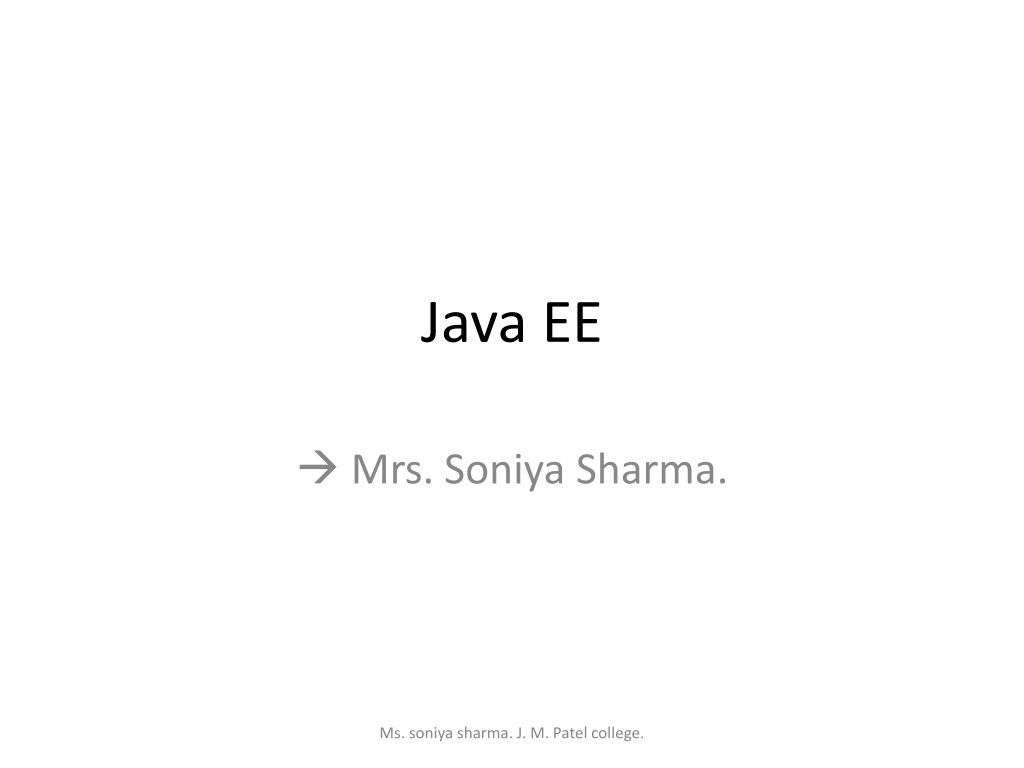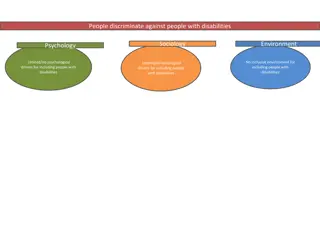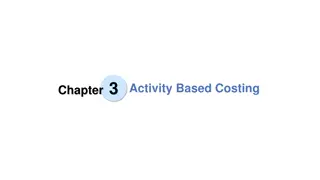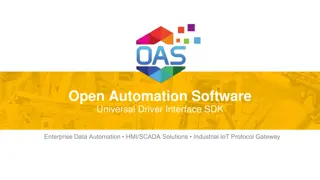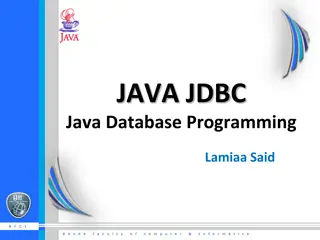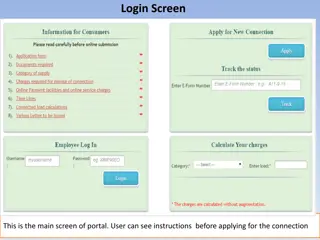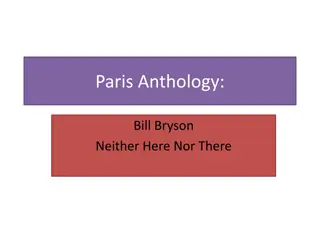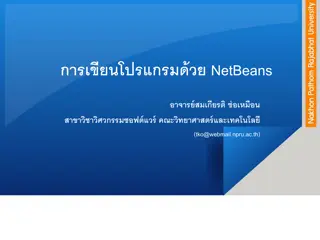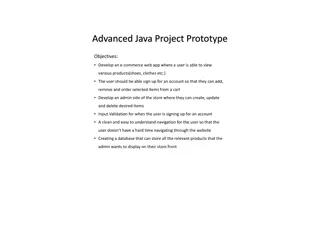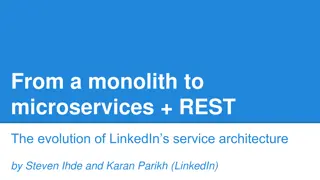JDBC Drivers and Connection Process
This content explains the steps to connect to a database using JDBC, covering JDBC drivers such as JDBC-ODBC Bridge Driver and JDBC Native API. It also discusses connecting to a database, executing queries, and handling result sets. Additionally, it introduces the RequestDispatcher interface for server-side request handling.
Download Presentation

Please find below an Image/Link to download the presentation.
The content on the website is provided AS IS for your information and personal use only. It may not be sold, licensed, or shared on other websites without obtaining consent from the author.If you encounter any issues during the download, it is possible that the publisher has removed the file from their server.
You are allowed to download the files provided on this website for personal or commercial use, subject to the condition that they are used lawfully. All files are the property of their respective owners.
The content on the website is provided AS IS for your information and personal use only. It may not be sold, licensed, or shared on other websites without obtaining consent from the author.
E N D
Presentation Transcript
Java EE Mrs. Soniya Sharma. Ms. soniya sharma. J. M. Patel college.
Steps to connect to DB Import JDBC packages. import java.sql.*; Load and register the JDBC driver. DriverManager.registerDriver(new oracle.jdbc.driver.OracleDriver()); Class.forName("oracle.jdbc.driver.OracleDriver"); Open a connection to the database. Connection conn = DriverManager.getConnection(URL, username, passwd); Connection conn = DriverManager.getConnection(URL); Create a statement object to perform a query. Statement sql_stmt = conn.createStatement(); Ms. soniya sharma. J. M. Patel college.
Steps to connect to DB Execute the statement object and return a query resultset. ResultSet rset = sql_stmt.executeQuery ("SELECT empno, ename, sal, deptno FROM emp ORDER BY ename"); Process the resultset. while (rset.next()) getInt(), getString() ,getFloat() Close the resultset and statement objects. rset.close() sql_stmt.close() Close the connection. conn.close(); Ms. soniya sharma. J. M. Patel college.
JDBC-ODBC BRIDGE DRIVER: This driver connect a java program with a database using Odbc driver. It is install automatically along with JDK software. It is provided by Sun MicroSystem for testing purpose this driver can not be used in real time application. This driver convert JDBC calls into Odbc calls(function) So this is called a bridge driver. Advantage of bridge driver Easy to use Can be easily connected to any database. This driver software is built-in with JDK so no need to install separately. Disadvantage of bridge driver It is a slow driver so not used in real time application It is not a portable driver. Ms. soniya sharma. J. M. Patel college.
Jdbc-Native API : JDBC API calls are converted into native c/c++ API calls which are unique to the database. For this vendor specific driver must be installed on each client machine. Advantage of Thin driver Native API driver comparatively faster than JDBC- ODBC bridge driver. Disadvantage of Thin driver Native API driver is database dependent and also platform dependent because of Native API. Ms. soniya sharma. J. M. Patel college.
RequestDispatcher interface The RequestDispatcher interface defines an object that receives the request from client and dispatches it to the resource(such as servlet, JSP, HTML file). This interface has following two methods: public void forward(ServletRequest request, ServletResponse response): It forwards the request from one servlet to another resource (such as servlet, JSP, HTML file). public void include(ServletRequest request, ServletResponse response): It includes the content of the resource(such as servlet, JSP, HTML file) in the response. Ms. soniya sharma. J. M. Patel college.
Cookies Cookie is a small piece of information that is persisted between the multiple client requests. A cookie has a name, single value and optional attributes such as comment, path , maximum age and version number. By default, each request is considered as a new request. In cookies technique, we add cookie with response from the servlet. So cookie is stored in the cache of the browser. After that if request is sent by the user, cookie is added with request by default. Thus we recognize user as the old user. Ms. soniya sharma. J. M. Patel college.
Kinds of Cookies There are two kinds of cookies in servlet. Non-persistent Cookie / session cookies It is valid for single session only. It is removed each time when user closes the browser. Session cookies are stored in memory and are accessible as long as the user is using the web application. Session cookies are lost when user exits the web application. Session cookies are identified by session id and are most commonly used to store details of shopping cart. Persistent Cookie / permanent cookies It is valid for multiple sessions. It is not removed each time when user closes the browser. Permanent cookies are used to store long term information such as user preferences and user identification information. These are stored in persistence storage and are not lost when user exits the application. Permanent cookies are lost when they expire. Ms. soniya sharma. J. M. Patel college.
Advantages and Disadvantages of Cookies Advantages : Simplest technique of maintaining the state. Cookies are maintained at client side. Disadvantages: It will not work if cookie is disabled from the browser. Only textual information can be set in cookie object. Some web browsers limit the number of cookies (typically 20 per web server) that can be installed. Cookies cannot identify a particular user. A user can be identified by a combination of user account, browser and computer. So, users who have multiple accounts and use multiple computers/browsers have multiple sets of cookies. Consequently, cookies cannot differentiate between multiple browsers running in a single computer. Intruders can snoop, steal cookies, and attack sessions. This is called session hijacking. Ms. soniya sharma. J. M. Patel college.
Where Cookies are used? Cookies are most commonly used to tract website activity. Cookies are used for Online shopping. Online stores uses cookies that record any personal information you enter as well as any items in your electronic shopping cart. So that you don t need to reenter this information each time you visit the site. Servers can use cookies to provide personalized web pages. When you select preferences at site that uses this option, the server places the information in a cookie. When you return, the server uses the information in cookie to create a customized page for you. Ms. soniya sharma. J. M. Patel college.
Creating cookies using servlet Cookie class javax.servlet.http.Cookie class provides the functionality of using cookies. It provides a lot of useful methods for cookies. Cookie()constructs a cookie. Cookie(String name, String value)constructs a cookie with a specified name and value. Ms. soniya sharma. J. M. Patel college.
Other methods required for using Cookies void addCookie(Cookie ck): method of HttpServletResponse interface is used to add cookie in response object. public Cookie[] getCookies(): method of HttpServletRequest interface is used to return all the cookies from the browser. Example Ms. soniya sharma. J. M. Patel college.
Sessions HTTP protocol and Web Servers are stateless, what it means is that for web server every request is a new request to process and they can t identify if it s coming from client that has been sending request previously. Session is a conversional state between client and server and it can consists of multiple request and response between client and server. Since HTTP and Web Server both are stateless, the only way to maintain a session is when some unique information about the session (session id) is passed between server and client in every request and response. Ms. soniya sharma. J. M. Patel college.
Session Tracking Techniques To recognize the user we do session tracking. There are four techniques used in Session tracking: Cookies - Done Hidden Form Field URL Rewriting HttpSession Ms. soniya sharma. J. M. Patel college.
Session Tracking Techniques Hidden form field. In case of Hidden Form Field a hidden (invisible) textfield is used for maintaining the state of an user. In such case, we store the information in the hidden field and get it from another servlet. <input type="hidden" name="uname" value="Vimal Jais wal"> Here, uname is the hidden field name and Vimal Jaiswal is the hidden field value. Advantage of Hidden Form Field It will always work whether cookie is disabled or not. Disadvantage of Hidden Form Field: It is maintained at server side. Extra form submission is required on each pages. Only textual information can be used. Ms. soniya sharma. J. M. Patel college.
URL Rewriting You can append some extra data on the end of each URL that identifies the session, and the server can associate that session identifier with data it has stored about that session. For example, with http://tutorialspoint.com/file.htm;sessionid = 12345, the session identifier is attached as sessionid = 12345 which can be accessed at the web server to identify the client. Advantage : URL rewriting is a better way to maintain sessions and it works even when browsers don't support cookies. Disadvantage: You have to generate every URL dynamically to assign a session ID, even in case of a simple static HTML page. Ms. soniya sharma. J. M. Patel college.
URL Rewriting HttpSession container creates a session id for each user.The container uses this id to identify the particular user. An object of HttpSession can be used to perform two tasks: bind objects view and manipulate information about a session, such as the session identifier, creation time, and last accessed time. Ms. soniya sharma. J. M. Patel college.
Getting the HttpSession object : The HttpServletRequest interface provides two methods to get the object of HttpSession: public HttpSession getSession():Returns current session associated with request, if request does not have a session, creates one. public HttpSession getSession(boolean create):Returns the current HttpSession associated with request, if there is no current session and create is true, returns a new session. Methods of HttpSession interface public String getId():Returns string containing the unique identifier value. public long getCreationTime():Returns the time when this session was created public long getLastAccessedTime():Returns the last time the client sent request associated with this session public void invalidate():Invalidates session, unbinds any objects bound to it. Ms. soniya sharma. J. M. Patel college.
index.html <form action="servlet1"> Name:<input type="text" name="userName"/><br/> <input type="submit" value="go"/> </form> Ms. soniya sharma. J. M. Patel college.
FirstServlet.java import java.io.*; import javax.servlet.*; import javax.servlet.http.*; public class FirstServlet extends HttpServlet { public void doGet(HttpServletRequest request, HttpServletRe sponse response){ try{ response.setContentType("text/html"); PrintWriter out = response.getWriter(); String n=request.getParameter("userName"); out.print("Welcome "+n); HttpSession session=request.getSession(); session.setAttribute("uname",n); out.print("<a href='servlet2'>visit</a>"); out.close(); }catch(Exception e){System.out.println(e);} } } Ms. soniya sharma. J. M. Patel college.
SecondServlet.java import java.io.*; import javax.servlet.*; import javax.servlet.http.*; public class SecondServlet extends HttpServlet { public void doGet(HttpServletRequest request, HttpServletR esponse response) try{ response.setContentType("text/html"); PrintWriter out = response.getWriter(); HttpSession session=request.getSession(false); String n=(String)session.getAttribute("uname"); out.print("Hello "+n); out.close(); }catch(Exception e){System.out.println(e);} } } Ms. soniya sharma. J. M. Patel college.
Above example describes how to use the HttpSession object to find out the creation time and the last-accessed time for a session, number of times page is accessed. We would associate a new session with the request if one does not already exist. protected void doGet(HttpServletRequest request, HttpServletResponse response)throws ServletException, IOException { HttpSession session = request.getSession(true); Date createTime = new Date(session.getCreationTime()); Date lastAccessTime = new Date(session.getLastAccessedTime()); String title = "Welcome Back to my website"; int visitCount = 0; String visitCountKey = "visitCount"; String userIDKey = "userID"; String userID = "ABCD"; if (session.isNew()) { title = "Welcome to my website"; session.setAttribute(userIDKey, userID); } else { visitCount = (int)session.getAttribute(visitCountKey); visitCount = visitCount + 1; userID = (String)session.getAttribute(userIDKey); } Ms. soniya sharma. J. M. Patel college.
session.setAttribute(visitCountKey, visitCount); response.setContentType("text/html"); PrintWriter out = response.getWriter(); out.println(title); out.println(session.getId()); out.println(createTime); out.println(lastAccessTime); out.println(userID); out.println(visitCount); } Ms. soniya sharma. J. M. Patel college.
Working with Files A Servlet can be used with an HTML form tag to allow users to upload files to the server. An uploaded file could be a text file or image file or any document. Creating a File Upload Form The following HTM code below creates an up loader form. Following are the important points to be noted down The form method attribute should be set to POST method and GET method can not be used The form enctype attribute should be set to multipart/form-data. The form action attribute should be set to a servlet file which would handle file uploading at backend server. Following example is using UploadServlet servlet to upload file. To upload a single file you should use a single <input .../> tag with attribute type="file". To allow multiple files uploading, include more than one input tags with different values for the name attribute. The browser associates a Browse button with each of them. Ms. soniya sharma. J. M. Patel college.
Working with Files <html> <head> <title>File Uploading Form</title> </head> <body> <h3>File Upload:</h3> Select a file to upload: <br /> <form action = "UploadServlet" method = "post" enctype = "multipart/form-data"> <input type = "file" name = "file" size = "50" /> <br /> <input type = "submit" value = "Upload File" /> </form> </body> </html> Ms. soniya sharma. J. M. Patel college.
Working with Non-Blocking I/O Blocking I/O Blocking IO wait for the data to be write or read before returning. Java IO's various streams are blocking. It means when the thread invoke a write() or read(), then the thread is blocked until there is some data available for read, or the data is fully written. It is stream oriented. The I/O operation using this approach is slow. A stream can be used for one-way data transfer. Non blocking I/O Non blocking IO does not wait for the data to be read or write before returning. Java NIO non- blocking mode allows the thread to request writing data to a channel, but not wait for it to be fully written. The thread is allowed to go on and do something else in a mean time. It is buffer oriented. Data is read into a buffer from which it is further processed using a channel. In NIO we deal with the channel and buffer for I/O operation. A channel provides a two-way data transfer facility. Ms. soniya sharma. J. M. Patel college.
Stream Oriented Java IO is stream oriented I/O means we need to read one or more bytes at a time from a stream. It uses streams for transferring the data between a data source/sink and a java program. Ms. soniya sharma. J. M. Patel college.
Buffer Oriented Java NIO is buffer oriented I/O approach. Data is read into a buffer from which it is further processed using a channel. In NIO we deal with the channel and buffer for I/O operation. The major difference between a channel and a stream is: A stream can be used for one-way data transfer. A channel provides a two-way data transfer facility. Therefore with the introduction of channel in java NIO, the non-blocking I/O operation can be performed. Ms. soniya sharma. J. M. Patel college.
Buffer Oriented Java NIO is buffer oriented I/O approach. Data is read into a buffer from which it is further processed using a channel. In NIO we deal with the channel and buffer for I/O operation. The major difference between a channel and a stream is: A stream can be used for one-way data transfer. A channel provides a two-way data transfer facility. Therefore with the introduction of channel in java NIO, the non-blocking I/O operation can be performed. Ms. soniya sharma. J. M. Patel college.
JSP Mrs. Soniya Sharma. Ms. soniya sharma. J. M. Patel college.
JSP JavaServer Pages (JSP) is a technology for developing Webpages that supports dynamic content. This helps developers insert java code in HTML pages by making use of special JSP tags. JSP Processing Ms. soniya sharma. J. M. Patel college.
JSP Life Cycle A JSP life cycle is defined as the process from its creation till the destruction. This is similar to a servlet life cycle with an additional step which is required to compile a JSP into servlet. The JSP life cycle includes following paths 1. Compilation 2. Initialization 3. Execution 4. Cleanup Ms. soniya sharma. J. M. Patel college.
JSP LifeCycle 1. Compilation : If the page has never been compiled, or if the JSP has been modified since it was last compiled, the JSP engine compiles the page. The compilation process involves three steps Parsing the JSP. Turning the JSP into a servlet. Compiling the servlet. 2. Initialization : When a container loads a JSP it invokes the jspInit() method before servicing any requests. If you need to perform JSP-specific initialization, override the jspInit(). Initialization is performed only once. Generally initialize database connections, open files, and create lookup tables done in the jspInit(). Ms. soniya sharma. J. M. Patel college.
JSP LifeCycle 3. Execution : Whenever a browser requests a JSP and the page has been loaded and initialized, the JSP engine invokes the _jspService()method in the JSP. The _jspService() method takes an HttpServletRequest and an HttpServletResponse as its parameters. The _jspService() method of a JSP is invoked on request basis. jspService() generats responses to all seven of the HTTP methods, i.e, GET, POST, DELETE, etc. 4. Cleanup : when you need to perform any cleanup, such as releasing database connections or closing open files, jspDestroy() is called which is equivalent to destroy() method of servlet. Ms. soniya sharma. J. M. Patel college.
JSP Pros & Cons Advantages of JSP 1. HTML friendly simple and easy language and tags. 2. Supports Java Code. 3. Supports standard Web site development tools. Disadvantages of JSP 1. As JSP pages are translated to servlets and compiled, it is difficult to trace errors occurred in JSP pages. 2. JSP pages require double the disk space to hold the JSP page because JSP pages are translated into class files, the server has to store the resultant class files with the JSP pages. 3. JSP pages must be compiled on the server when first accessed. This initial compilation produces a noticeable delay when accessing the JSP page for the first time. Ms. soniya sharma. J. M. Patel college.
Elements of JSP 1. The Scriptlet : A scriptlet can contain any number of JAVA language statements, variable or method declarations, or expressions. <% code %> 2. JSP Declarations : variable or method must be declared before you use. <%! int i = 0; %> <%! int a, b, c; %> <%! Circle a = new Circle(2.0); %> Ms. soniya sharma. J. M. Patel college.
Elements of JSP 3. JSP Expression: <%= expression %> <%= (new java.util.Date()).toLocaleString()%> 4. JSP Comments <%-- This is JSP comment --%> <! HTML comment --> Ms. soniya sharma. J. M. Patel college.
Elements of JSP 5. JSP Directives A JSP directive affects the overall structure of the servlet class. There are three types of directive tag 1. <%@ page ... %> Defines page-dependent attributes, such as scripting language, error page, and buffering requirements. 2. <%@ include ... %> Includes a file during the translation phase. 3. <%@ taglib ... %> Declares a tag library, containing custom actions, used in the page Ms. soniya sharma. J. M. Patel college.
Elements of JSP 6. JSP Actions You can dynamically insert a file, reuse JavaBeans components, forward the user to another page, or generate HTML for the Java plugin. <jsp:action_name attribute="value" /> a. jsp:include - Includes a file at the time the page is requested. b. jsp:useBean - Finds or instantiates a JavaBean. c. jsp:setProperty - Sets the property of a JavaBean. d. jsp:getProperty - Inserts the property of a JavaBean into the output. e. jsp:forward - Forwards the requester to a new page. f. jsp:text - Used to write template text in JSP pages and documents. g. jsp:plugin - Generates browser-specific code that makes an OBJECT or EMBED tag for the Java plugin. h. jsp:element - Defines XML elements dynamically. i. jsp:attribute - Defines dynamically-defined XML element's attribute. j. jsp:body - Defines dynamically-defined XML element's body. Ms. soniya sharma. J. M. Patel college.
